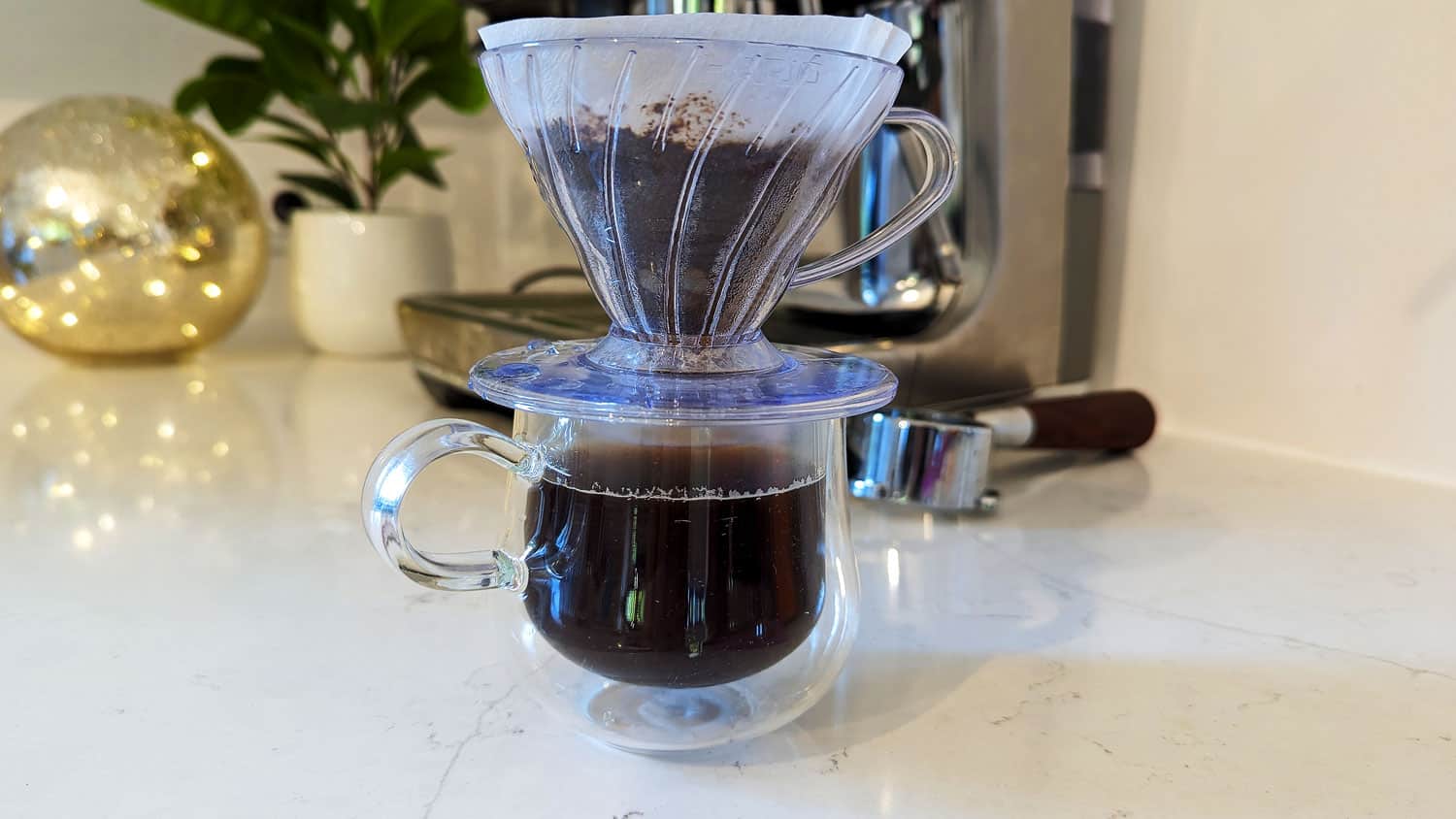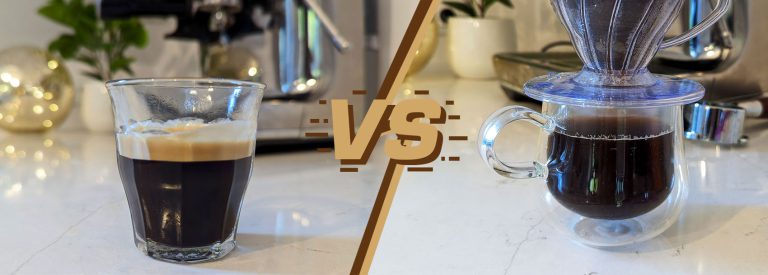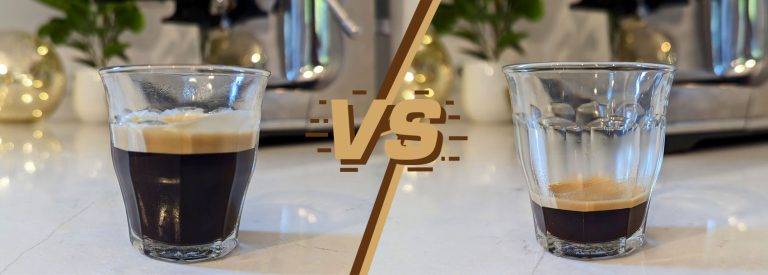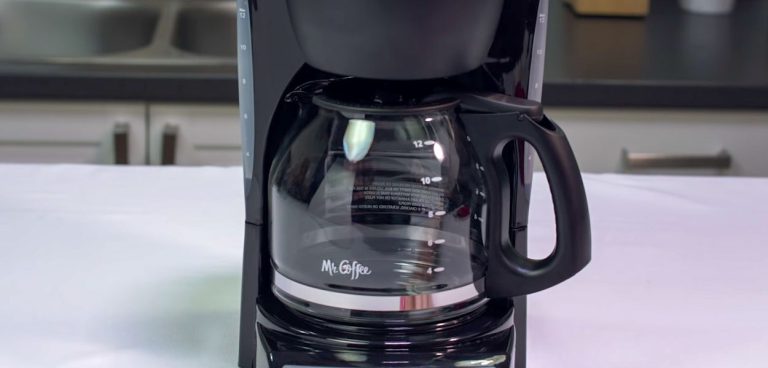Ristretto vs Drip Coffee: Potent Favorite and Smooth Classic Compared
Ristretto and drip coffee are two classic drinks that continue to make waves around the world. But if you’re not too familiar with the world of coffee, you will have no clue what they are 🙂 Don’t worry, I’ve been there.
To help, in this article, I wanted to share the unique characteristics of each drink and how they compare to each other. By the end of this read, you’ll be well-equipped with the knowledge to distinguish the ristretto and drip coffee.
Key takeaway: What’s the difference between Drip Coffee and Ristretto?
Ristretto, an espresso variation from Italy, boasts a concentrated coffee-to-water ratio of 1:1.5, resulting in an intense, slightly sweet, and acidic flavor with a dense and syrupy texture. On the other hand, Drip Coffee is made by letting water flow through a bed of coffee grounds in a filter at a coffee-to-water ratio of 1:16 to 1:17, delivering a milder, cleaner taste that showcases subtle notes of the cup.
Now let’s dive into the details.
What is a Ristretto?
Ristretto is an espresso variation from Italy that gained popularity because of its intensity. Its name is Italian for “restricted” which refers to the limited amount of water used while brewing this drink.

The coffee-to-water ratio for Ristretto is 1:1.5. To brew a single traditional Italian Ristretto, you need 7g of ground coffee while third-wave specialty coffee leans towards 9g. This results in a shot size of 0.7 oz (20 ml), which is served in a demitasse.
Each shot has 2 calories, and 60 to 80 mg of caffeine, just like an espresso. The reason for this is that most of the caffeine is extracted in the first 15-20 seconds of brewing, which is exactly how long you’d brew the ristretto.
About its flavor, Ristretto has a more concentrated and bold flavor profile than regular espresso. What I like about it is that the shorter extraction time puts emphasis on the coffee’s sweet and aromatic notes while reducing the bitterness. But this means that you have to watch the type of beans you use. For example, light roast beans will become way too acidic with a ristretto, which is why you should op for a medium, or even light-dark roast.
Here are the steps to making this drink:
- Grind coffee beans to your standard espresso grind size.
- Place the coffee grounds in the filter basket.
- Tamp the coffee grounds firmly.
- Lock the portafilter in your espresso machine and press the brew button.
- Aim for a shot pulled within 15-18 seconds only.
You can also read my in-depth guide on how to make a Ristretto for a perfect pull.
And if you’re interested in brewing Ristretto, I recommend you should strong by choosing one of these espresso coffee beans.
Now let’s check out what drip coffee is all about.
What is Drip Coffee?
Filtered coffee, more commonly known as drip coffee, has a history from the early 1900s. This brewing method involves pouring hot water over ground coffee beans, and the resulting coffee is sifted through a filter before dripping into a pot or cup. No machines, pistons, or electricity are needed… Just hot water and gravity at its finest.

It uses the Golden Ratio of 1:16 to 1:17 to brew 10g of ground coffee into a 6oz serving of drip coffee. It is served in a coffee mug with a 240-300 ml (8-10 oz) capacity.
Each serving has 50-90 mg of caffeine and just 2 calories. The calorie count is too small though so I just consider my cup calorie-free.
Drip coffee’s taste leans towards the milder side with a more subdued flavor profile when compared to the ristretto and other espresso-based coffees. Its clean and straightforward taste lets the subtle nuances of the coffee beans shine. Depending on various factors, you might detect notes ranging from citrus to chocolate or even floral undertones. As for the texture, it’s light and watery, making it a great choice for slow sipping.
Here’s how easily you can brew drip coffee:
- Grind your coffee to a medium coarse consistency.
- Fill the machine’s reservoir with water if you’re using a drip coffee machine, or heat water for a V60 or Chemex.
- Position your filter and introduce the coffee grounds.
- Simply hit the “brew” button and patiently await your coffee.
For more details, you can follow my step-by-step guide on how to use a drip coffee maker.
Ristretto vs Drip Coffee: How Do These Drinks Differ?
Here’s an overview of the characteristics of each coffee drink compared side by side:
| Aspect | Ristretto | Drip Coffee |
|---|---|---|
| Taste and Texture | Concentrated, bold, sweet, acidic, dense, and syrupy. | Milder, clean, notes of citrus/chocolate/floral, light and watery. |
| Coffee-to-Water Ratio | 1:1.5 | 1:16-1:17 (Golden Ratio) |
| Ingredient Ratio | Just coffee with less water than an espresso. | Just coffee. |
| Typical Serving Size | 0.7 oz (20 ml) | 6 oz (180 ml) |
| Caffeine Content | 60-80 mg per shot | 50-90 mg per 6oz cup |
| Calories | 2 calories per shot | 2 calories per 6 oz cup |
| Acidity | High acidity | Generally moderate acidity |
| Brewing Difficulty | Intermediate | Easy |
| Bean Roast | Medium to dark roasts | Light to medium roasts |
Now, let’s break down the key differences of Lungo and drip coffee:
- Ground Coffee Weight & Ratios: Ristretto uses a compact brew ratio of 1:1.5, while drip coffee brews with more water following a 1:16 to 1:17 coffee-to-water ratio. As for the coffee grounds, Ristretto uses 7g (9g for third-wave coffee) while drip coffee uses 10g of coffee per 6oz serving.
- Taste: As a more concentrated espresso, the Ristretto is a burst of intense, slightly sweet, and acidic flavor with a dense and syrupy texture, emphasizing the coffee’s aromatic notes. Meanwhile, drip coffee provides a milder, cleaner taste that showcases subtle notes of citrus, chocolate, or floral undertones (depending on your beans) in a light, watery texture.
- Volume, Calories, & Caffeine: The two drinks are very different in volume. A Ristretto is only 0.7 oz per shot while drip coffee typically has a larger serving of 6 oz. A shot of Ristretto has 60-80 mg of caffeine while drip coffee has 50-90 mg but both share an amount of just 2 calories.
- Bean Roast: For Ristretto, I use medium to light-dark roasts because light roasts are too bright. Overly dark roasts are too bitter though, so be mindful of this. I use light to medium roasts for drip coffee to let my coffee beans’ flavors shine.
- Serving Suggestions: Ristretto pairs well with small sweets like chocolate truffles and cookies, making it perfect after a big meal when a light coffee touch is desired.
Drip coffee, being versatile, complements breakfast and also allows for seasonal variations. I like making myself cinnamon coffee during the fall 🙂
As you can see, Ristretto and drip coffee are very different from each other. Not only are they brewed completely differently, but ristretto is very concentrated and potent, while drip coffee is smooth and mild.
Conclusion
Drip coffee is pretty convenient for brewing my daily cup while working, but still, I think I enjoy sipping on Ristretto more. Its bold, intense flavor serves as a quick pick-me-up after a bigger meal, which is when I will usually have one.







